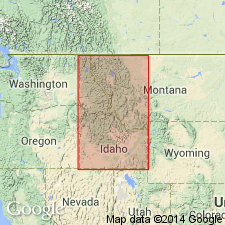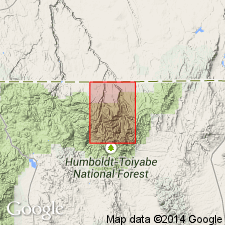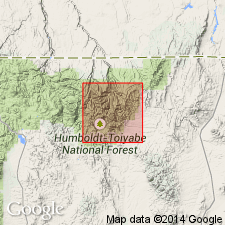
- Usage in publication:
-
- Jenny Creek formation
- Modifications:
-
- Revised
- Redescribed
- Dominant lithology:
-
- Ash
- Tuff
- Shale
- Sandstone
- Conglomerate
- AAPG geologic province:
-
- Great Basin province
Summary:
Pg. 6 (table 1), 10-11. Jenny Creek formation, middle formation in Idavada volcanics, herein recognized as group. Redescribed from Jenny Creek tuff to Jenny Creek formation to reflect inclusion of sedimentary rocks. Thickness about 600 feet in Trapper Creek area, Cassia County, Idaho [this report]. Consists of pumiceous ash, vitric tuff and minor amounts of shale, sandstone, conglomerate, limestone and lignitic beds. Middle part includes several beds of quartz latite welded tuff and perlitic glass. Grades upward into Cougar Point formation of Idavada. Rests on Beaverdam formation (new), also of Idavada, with slight angular unconformity in valley of Trapper Creek, but apparently is conformable with it in drainage of Beaverdam Creek to south. Age is Miocene (Barstovian). Previously mapped as lower part of Salt Lake formation by Mapel and Hail (USGS Bull. 1055-H, 1959); Salt Lake differs in lithology and stratigraphic position from Jenny Creek. Report includes stratigraphic charts.
Source: US geologic names lexicon (USGS Bull. 1350, p. 370); GNU records (USGS DDS-6; Denver GNULEX).

- Usage in publication:
-
- Jenny Creek tuff*
- Modifications:
-
- Named
- Dominant lithology:
-
- Tuff
- AAPG geologic province:
-
- Great Basin province
Summary:
Pg. M13, pI. 1 (geol. map). Jenny Creek tuff. White to pale-yellow or buff massive to well-bedded vitric tuffs, poorly consolidated. Locally includes thin layers of welded tuff. Type section includes one layer, about 3 feet thick, of dark-gray rhyolite welded tuff with crystals of quartz, sanidine, andesine, magnetite, apatite, and zircon. Thickness 60 to about 330 feet. Tuff is patchily distributed across full width of Jarbidge quadrangle and rests everywhere with depositional contact on Jarbidge rhyolite, Pole Creek dacite, or Slide Creek gravel (new). Locally intruded by Robinson Creek dacite. Underlies, with probable gradational contact, Cougar Point welded tuff (new). Malde and Powers (1962) applied name Idavada volcanics to unit that includes Cougar Point welded tuff and Jenny Creek tuff and possibly other rocks not represented in Jarbidge quadrangle. Deforms easily when water saturated and is subject to landsliding. Age is Pliocene, based on fossils (diatoms). Adopted by the USGS.
Type locality: on Jack Creek, just below mouth of Jenny Creek, in secs. 3 and 4, T. 46 N., R. 58 E., north-central Elko Co., northeastern NV. Named from Jenny Creek.
Source: US geologic names lexicon (USGS Bull. 1350, p. 370); supplemental information from GNU records (USGS DDS-6; Denver GNULEX).

- Usage in publication:
-
- Jenny Creek Tuff*
- Modifications:
-
- Age modified
- AAPG geologic province:
-
- Great Basin province
Summary:
Age modified from Pliocene to late Miocene. K-Ar age date of 12.2 +/-0.8 m.y. on sanidine from younger Cougar Point Tuff from Owyhee quad, 40 mi to west by Obradovich (Coats, Stephens, 1968, Ore deposits of the United States, 1933-1967, v. 2, p. 1083) and middle Miocene age based on other published isotopic age dates for older Jarbidge Rhyolite implies that Jenny Creek is late Miocene.
Source: GNU records (USGS DDS-6; Denver GNULEX).
For more information, please contact Nancy Stamm, Geologic Names Committee Secretary.
Asterisk (*) indicates published by U.S. Geological Survey authors.
"No current usage" (†) implies that a name has been abandoned or has fallen into disuse. Former usage and, if known, replacement name given in parentheses ( ).
Slash (/) indicates name conflicts with nomenclatural guidelines (CSN, 1933; ACSN, 1961, 1970; NACSN, 1983, 2005, 2021). May be explained within brackets ([ ]).

